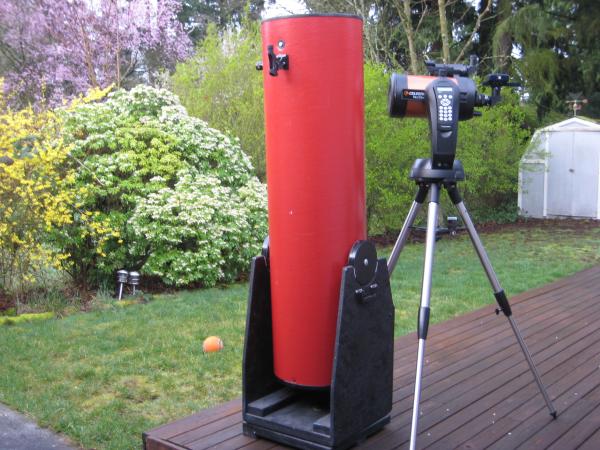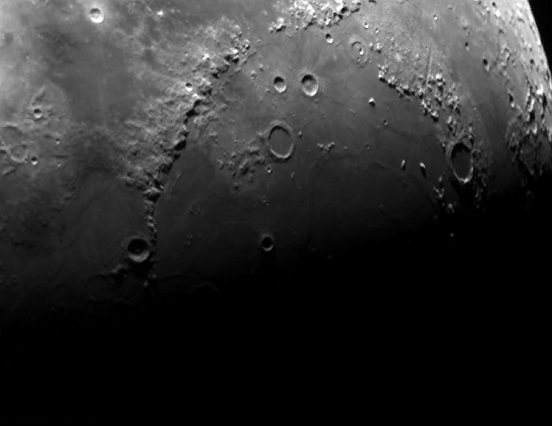Astronomy Tutorial
Telescopes
Good beginner telescopes sold in department stores?
What is a good beginner telescope? Is that Walmart telescope good enough? How much magnification do I need to have for my telescope to see the Moon, planets or galaxies?
These are usual questions asked by many beginner amateur astronomers. And the answer to all of these question is... get informed first.And if you're really impatient for an answer, the short answer is that you may see only some details on the Moon with a cheap telescope and only if you can point constantly the telescope to the Moon (to overcome for the rather fast Earth rotation). Do not expect to see too much in a small and cheap telescope!
A good beginner telescope is one you can really enjoy... A telescope that will create passion for astronomy, the desire to get outside during night time to look at the beautiful cosmos. If the expectations are set right, even a small aperture telescope with a decent mount and a well aligned finderscope can do just fine. Eventually, later on, you'll want a bigger telescope. A small telescope can be used for visual observations of the moon, to check some open clusters, some bright nebulae, double or variable stars.
A small decent telescope is not very expensive (usually it gets around a couple hundreds of dollars in USA). There are even cheaper telescopes in department stores but... a lot of them may actually work as hobby killers - push people far away from stargazing and amateuer astronomy. Why is that? Because the marketing on these telescopes claims are on the legal borderline and they fuel false expectations for their buyers...
Here is one example. You see this small telescope (50 mm aperture) that claims 600x magnification power for 30$ - 50$. The box shows the picture of happy people looking through the telescope and then a few colorful Hubble quality shots of some planets (Jupiter, Saturn, Mars) or of Andromeda galaxy. By association, our brain will tell (incorrectly) that you may see some far away galaxy with all the details depicted in that picture. But that's really wrong, wrong, wrong!
You can't see a any galaxy details (arms, dust lanes thorugh such a small telescope). You can not see any polar caps from Mars or the Jupiter red spot (as they look in the pictures).
And the magnification power means nothing. Do not look at magnification power values when buying a telescope. Look instead at their aperture size (diameter of the entry lens of the telescope tube - or of the primary mirror in case of a Newtonian or SCT telescope). Different magnification levels can be achieved by using different eye pieces. Telescopes come with interchangable eye pieces - a set of 2 or 3 lens (named eye pieces). By using different eye pieces (with different f values), you'll get different magnification level.
The main function of a telescope is not to mangnify the image but to gather way more light that it's possible to be done without any visual aid. Just compare the telescope with a large eye. If it's larger, it will see more light and you'll get a brighter, higher quality/resolution image. You can achieved high magnification in small telescopes, too - but the image is going to be very blury and not usefull. It would be like you want to watch a very small resolution movie (200x160 pixels) on a big 52'' HDTV. The image will look actually worse compared the same image running on a small mobile phone screen.
Both are pictures at the same level of magnification. But the image on the left is what you can expect to see through a decent telescope, while on the right is what you can get (if you're lucky) with a smaller and cheap department store telescope.
Another problem to overcome by new telescope owners is to point their telescopes in the right directions and adjust continously the tripod oriented to the desired target (overcoming for the rotation of the Earth).
Let's say you got your new telescope and want to see the moon.
If you don't have a red dot finder already installed and well aligned with the telescope, pointing the telescope to the moon proves to be more difficult than anticipated.
The image, as seen at the telescope's eye piece, don't have the same orientation as the real image. If you overcome this problem and succeed pointing the telescope in the right direction, you'll find up that in a matter of 2-3 minutes the moon may be out of your field of view. You have to continously adjust for the Earth rotation (apparent sky objects movement). This can be done easy if you have a good telescope mount. But if this is not the case, then the observation session may end up with frustration.
What is a good mount for visual observing?
The short answer is a mount that will remain motionless after you point it in the right direction. Some bad and cheap mounts will require a "lock movement" - for example to tight some screws. That is not a good design, because tighting the screws will know the telescope out of alignment (and your target - e.g. the moon - will not be visible anymore at the eyepiece).
But there are different mounts that are way better: dobsonian mounts, motor driven, goto mounts or EQ mounts are just a few examples.
What about good finderscope alignment?
Because what we see through the telescope's tube is a very small section of the sky (the telescope field of view), we need some sort of helper in the task of positioning the telescope in the right direction.
A small red dot finder can help a lot. It has a small laser beam projected on a glass. The user looks through the finder's glass and sees a red dot superimposed on the sky. This can help a lot at night time to point the telescope in the right direction. The trick is to get it aligned ahead of time, preferable during day time.
Just point the telescope to a far away location (a tip of a pole, a horn of a house, etc) and make sure that the red dot points at the same place as the telescope. The red dot finders have some adjustment screws to achieve good alignment.
- Type of telescopes: refractor, newtonian and SCT
- telescope mounts: standard (AltAz), equatorial, dobsonian
- telescope accesories: eyepieces, finderscopes, dew shields
- dark vision adaptation and observation tricks (peripheral vision, use an adjustable heigh chair, avoid exposure to light to preserve dark vision adaptation, stay warm and comfortable)
More coming soon!



